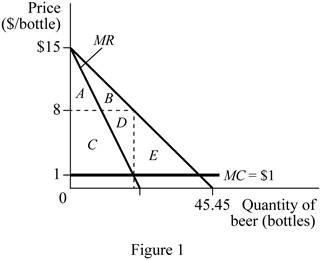
(a)
The profit maximizing price, quantity, consumer surplus and
(a)
Explanation of Solution
From the given data, the inverse demand function can be calculated using Equation (1) as follows:
The marginal revenue can be calculated as follows:
The marginal revenue function is
Given the marginal cost is $1.
The profit of a firm is maximized when marginal revenue is equal to the marginal cost.
The profit is maximized when the quantity is 21.21.
The price charged by the monopolist to maximize the profit can be calculated by substituting the value of profit maximizing output in Equation (1).
Thus, the profit maximizing output is 21.21 and the profit maximizing price is $8.
Figure 1 given below shows the demand and market revenue.

The horizontal axis of Figure 1 measures the quantity of bottles and the vertical axis measures the price per bottle. The demand curve and the marginal revenue curve are downward sloping curves. The marginal cost is constant and is fixed at $1.
The consumer surplus is the sum area of A and B. The consumer surplus can be calculated as follows:
Thus, the consumer surplus is $74.24.
The producer surplus is the area of C+D calculated as follows:
Thus, the producer surplus is $148.87.
The competitive equilibrium in the market is attained when the marginal cost is equal to the price which is equal to $1.
When the price is $1, the quantity demanded can be calculated by substituting the respective values in Equation (1).
The deadweight loss is the area given by DWL. It can be calculated as follows:
Thus, the deadweight loss is $74.24.
Consumer Surplus: The consumer surplus is defined as the difference between the maximum amount a person is willing to pay for consuming a commodity and the actual price he pays for it.
Producer Surplus: The producer surplus is defined as the difference between the actual market price for which a commodity is sold and the minimum cost at which the producer is willing to sell the commodity. This minimum accepted price is usually the cost of production of the commodity.
(b)
The price that the townsfolk would be willing to pay.
(b)
Explanation of Solution
The townsfolk would be willing to pay an amount equal to the consumer surplus when the price is equal to the marginal cost. The consumer surplus is the area given by the areas C+D+E.
The consumer surplus can also be calculated as the sum of the producer surplus and the deadweight loss.
The consumer surplus $222.71 is the price which the townsfolk would be willing to pay.
Consumer Surplus: The consumer surplus is defined as the difference between the maximum amount a person is willing to pay for consuming a commodity and the actual price he pays for it.
(c)
The minimum payment the brewery would be willing to pay.
(c)
Explanation of Solution
The minimum payment that the brewery would be willing to accept is the amount that can compensate the producer surplus at the competitive price of $1. Thus, the minimum payment made by the brewery is $148.47.
Producer Surplus: The producer surplus is defined as the difference between the actual market price for which a commodity is sold and the minimum cost at which the producer is willing to sell the commodity. This minimum accepted price is usually the cost of production of the commodity.
(d)
The potential bargain.
(d)
Explanation of Solution
Clearly, there exists a bargain. The agreed payment would probably fall in the range $148.47 and $222.71. There would be no deadweight loss if a bargain is struck. The actual payment would depend on the strength of the bargaining of the two sides.
Deadweight loss: Deadweight loss is defined as the loss of the total consumer surplus and producer surplus due to overproduction or underproduction.
Want to see more full solutions like this?
Chapter 9 Solutions
Microeconomics

 Principles of Economics (12th Edition)EconomicsISBN:9780134078779Author:Karl E. Case, Ray C. Fair, Sharon E. OsterPublisher:PEARSON
Principles of Economics (12th Edition)EconomicsISBN:9780134078779Author:Karl E. Case, Ray C. Fair, Sharon E. OsterPublisher:PEARSON Engineering Economy (17th Edition)EconomicsISBN:9780134870069Author:William G. Sullivan, Elin M. Wicks, C. Patrick KoellingPublisher:PEARSON
Engineering Economy (17th Edition)EconomicsISBN:9780134870069Author:William G. Sullivan, Elin M. Wicks, C. Patrick KoellingPublisher:PEARSON Principles of Economics (MindTap Course List)EconomicsISBN:9781305585126Author:N. Gregory MankiwPublisher:Cengage Learning
Principles of Economics (MindTap Course List)EconomicsISBN:9781305585126Author:N. Gregory MankiwPublisher:Cengage Learning Managerial Economics: A Problem Solving ApproachEconomicsISBN:9781337106665Author:Luke M. Froeb, Brian T. McCann, Michael R. Ward, Mike ShorPublisher:Cengage Learning
Managerial Economics: A Problem Solving ApproachEconomicsISBN:9781337106665Author:Luke M. Froeb, Brian T. McCann, Michael R. Ward, Mike ShorPublisher:Cengage Learning Managerial Economics & Business Strategy (Mcgraw-...EconomicsISBN:9781259290619Author:Michael Baye, Jeff PrincePublisher:McGraw-Hill Education
Managerial Economics & Business Strategy (Mcgraw-...EconomicsISBN:9781259290619Author:Michael Baye, Jeff PrincePublisher:McGraw-Hill Education





